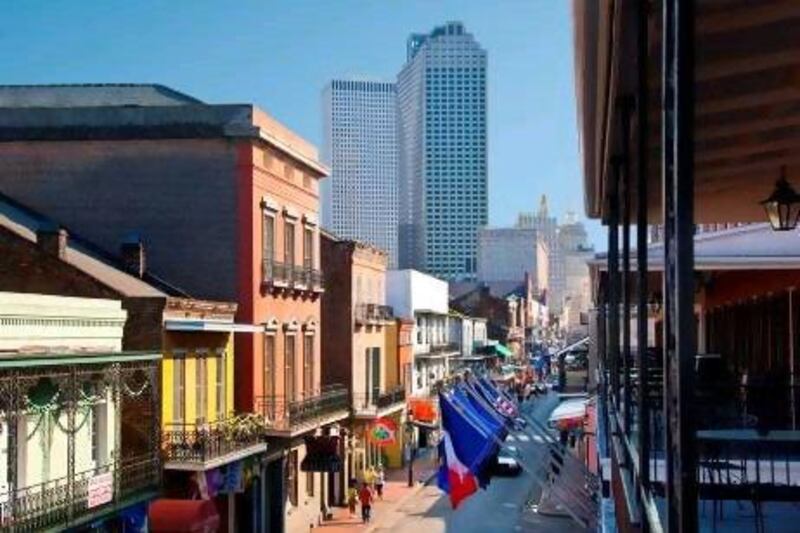Why New Orleans?
Jazz, Mardi Gras, shrimp Creole, steamboats on the Mississippi... New Orleans is one of those celebrated cities that comes with an instant snapshot of expectations.
The good news is it delivers the dream - and if you're worried about the aftermath of Hurricane Katrina, forget it. The Big Easy has moved on. Last year more than nine million visitors flocked there.
The big surprise is how small the place is. The population is a mere 350,000, which means it's a cinch to explore. Sensual and bohemian, it has always lived to its own rules, and offers a rich and intriguing culture born out of African slavery, European colonialism and American brio. You can see the best of it in three days; you may well want to stay forever.
A comfortable bed
New Orleans has a thriving hotel scene but steer clear of the raucous Bourbon Street and big modern boxes aimed at conventioneers.
In the French Quarter, the romantic 13-room Soniat House (www.soniathouse.com, doubles from $335 [Dh1,232]) is formed from two elegant 1830 townhouses. In the Central Business District, International House (www.ihhotel.com, from $134 [Dh495]) is a grand 1906 bank turned contemporary hotel. The city is also well stocked with upmarket guesthouses such as Terrell House (www.terrellhouse.com, from $169 [Dh621] with breakfast), a 1857 cotton broker's mansion in the Lower Garden District that has been gorgeously restored.
Find your feet
New Orleans rests beside a venerable bend in the Mississippi River. Most of the action lies on its northern bank, where the city is split by the long run of Canal Street. To its east lies the French Quarter, an atmospheric grid of streets with lusciously coloured buildings adorned with cast iron balconies gushing with flowers. Jackson Square is its hub, and the best way to explore is on foot.
West of Canal Street you'll find the Central Business District, a standard ensemble of skyscrapers, big name hotels, landmark museums and a gentrifying warehouse district.
Best reached on a rattling wooden streetcar, the Garden District is home to overblown antebellum mansions and the dreamy Lafayette Cemetery with ornate 19th century tombs. Another appealing neighbourhood is Bywater, lined with wooden "shotgun" houses now colonised by creative types. The best way to see it is on a guided bike tour (www.confederacyofcruisers.com). For more information see www.neworleanscvb.com.
Meet the locals
New Orleans is all about enjoying live music. This is the birthplace of jazz, with homegrown stars stretching from Louis Armstrong and Fats Domino to Wynton Marsalis. The city has more than 50 venues, principally in the French Quarter but also on the less commercial Frenchmen Street in Faubourg Marigny.
You can check out what's on at www.offbeat.com, but also seek local advice. If it's Thursday, many people will head to Vaughan's in Bywater (4229 Dauphine St), where the jazz trumpeter Kermit Ruffins plays regularly with this Barbecue Swingers.
Several engaging museums offer an introduction to local life. Two to seek out are the small Backstreet Cultural Museum (www.backstreetmuseum.org) in Tremé and the Ogden Museum of Southern Art (www.ogdenmuseum.org).
Book a table
New Orleans cuisine is rich and filling. Note the difference between dishes described as Creole (influenced by Europe and Africa, fancy and often seafood-centred) and Cajun (rustic, meat-based and spicy).
The city has a lively restaurant scene and it's wise to make a few reservations ahead of your trip, particularly for Sunday and Monday when many places are closed. Top of the list should be Herbsaint (www.herbsaint.com), where the Cajun chef Donald Link serves superb Louisiana fare including a daily gumbo, shrimp with grits and dirty rice. An average two-course evening meal costs around $37 (Dh136) per person. Head to Galvez (www.galvezrestaurant.com) to dine on local bouillabaisse ($30; Dh110) close to the Mississippi, and Galatoire's (www.galatoires.com, jacket required) to enjoy elaborate shrimp and crabmeat dishes in an animated, old school setting.
Shopper's paradise
Chartres Street, in the French Quarter, is well supplied with sassy women's boutiques such as Trashy Diva, which specialises in vibrantly coloured reproduction vintage dresses and shoes.
Men should smarten up at the classic outfitters Rubensteins and Meyer the Hatter (102 and 120 St Charles Ave).
New Orleans has inspired much great literature, from the sultry dramas of Tennessee Williams to punch-packed stories about Katrina, so go browsing at the friendly Garden District Bookshop (www.gardendistrictbookshop.com). International visitors can claim back nine per cent sales tax (www.louisianataxfree.com).
What to avoid
At weekends Bourbon Street becomes an intense party zone that is not for the faint-hearted. If you like to sightsee rather than dance avoid visiting during popular celebrations such as Mardi Gras, Jazz Fest and Halloween, when the city is packed.
Don't miss
New Orleans is merely the best-known city in Louisiana, a state that offers rewarding exploration by car. You can whizz around on the freeways or follow little-used scenic by-ways that wind through a delightful countryside of woods and farms.
Head northwest to St Francisville to visit stately plantation houses such as Rosewood and Oakley, where the naturalist John James Audubon painted 32 of his famous Birds of America series. For more information see www.louisianatravel.com.





